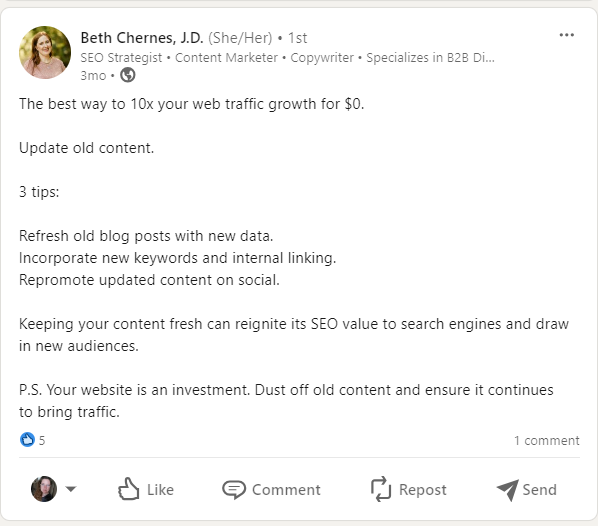As much as I love writing new content for the nDash blog, looking for content refresh opportunities is just as fun. While some view it as something they can push down their to-do list, I prefer a different approach.
The Importance of Content Refreshing
Did you know that even high-quality content can lose significant organic traffic over time if not updated? While the exact percentage can vary, search engines prioritize fresh, relevant content.
That’s the “quick answer” to why I like taking a different approach to content refreshing. Now, let’s get into some metrics (who doesn’t love data, right?):
Compared to those that don’t, on average, companies that blog see:
- 55% more visitors
- 97% more inbound links
- 434% more indexed pages
Why is knowing this important?
New or refreshed content drives website traffic and improves search engine ranking. One of our nDash community members, Beth Chernes, is also an SEO strategist.
👉 Her LinkedIn post below succinctly captures the importance of a content refresh:

User experience is also significantly impacted by content refreshing. Outdated information frustrates users, as it leads to confusion and wasted time. This frustration directly affects their perception of your website and their likelihood of returning.
Identifying Content Refresh Opportunities
Now, consider Beth’s advice above – your website is an investment. Spotting content refresh opportunities is an excellent way to ensure visitors return.
How to Analyze Content Performance
While only 15% of Google searches are brand new daily, this doesn’t negate the importance of regular content audits. Regularly assess your existing content. Look for emerging trends and ensure it’s still relevant. Doing so will keep your content visible, attract the right audience, and capture valuable traffic.
- Create a content inventory: List all content across types, channels, and formats.
- Perform a content audit: Assess content against customer needs and strategic goals. This process reveals strengths, weaknesses, and opportunities for updates.
- Set measurable goals: Prioritize based on potential impacts, like traffic growth or brand awareness. Key performance indicators (KPIs) will guide this analysis. Tools like Google Analytics help track these metrics.
Tools And Metrics to Identify Decay
Use SEO tools like Semrush or Google Analytics for insights. Monitor organic traffic, dwell time, and backlinks to assess the content’s SEO health. High incoming requests suggest quality content. Evaluate content age, topics, and alignment with brand initiatives. Is your content over one year old? If so, it’ll likely need a refresh.
Selecting Content With the Highest Potential For Improvement
- Choose content based on performance metrics like page views, bounce rates, and engagement.
- Prioritize evergreen topics with steady traffic potential.
- Assess against brand and SEO goals.
- Update information, improve formatting, and optimize for current SEO practices.
- Include visual and interactive elements to enhance engagement.
Content Refresh Strategy
Learning to identify content refresh opportunities is just a part of the process. After determining which content you need to refresh – you need a strategy.
What’s the point of a strategy?
I’m glad you asked!
Like a content strategy, a well-planned content refresh strategy ensures your website remains valuable and accurate.
Update Outdated Information
Ensuring your content remains accurate and up-to-date is foundational to maintaining your audience’s trust. Review your blog posts and other materials to correct outdated facts, statistics, and references. Doing so boosts credibility and keeps your content competitive in search engine results.
Improve SEO With Keyword Optimization
Did you know 94.74% of keywords get ten monthly searches or fewer? Improve your search engine ranking by researching and integrating relevant keywords into the content you want to refresh. This process involves revisiting old posts and updating them with keywords currently trending in your industry.
👉 Read more about keyword research here: Ahrefs Guide to Content Creation – nDash.com.
Enhance User Engagement Through Multimedia
Adding multimedia elements like images, videos, and infographics can dramatically increase user engagement. These elements make your content more appealing and digestible, encouraging visitors to spend more time on your site. Multimedia also provides additional value to your audience, making complex information easier to understand. Plus, you can repurpose these assets into your social media strategy – win, win!
Internal Linking
Strategic internal linking enhances the user experience and boosts your SEO efforts. By linking to other relevant pages, you can guide visitors to more helpful content, increasing their time spent on your site. Doing so also helps search engines understand your website’s structure, improving your pages’ visibility.
Use AI to Inform the Process
AI can help identify which pieces of content need updating, suggest relevant keywords based on current trends, and recommend internal linking opportunities. This technology makes it easier to keep your content strategy ahead of the curve and aligned with user interests and search engine algorithms. Here’s an example of what that looks like.
👉 ChatGPT prompts and results: We’d like to update the following URL to improve and optimize search engine performance for the target audience.
The Content Refresh Process
Strategizing your content refresh plan differs from going through the process. Let’s break that down:
Step-by-step Guide From Planning to Publishing
- Content audit: Evaluate your existing content to identify what needs updating, consolidating, or deleting. Look for outdated, underperforming pieces that no longer align with your brand’s goals and audience’s interests.
- Market research: Understand current trends, keywords, and what your audience is seeking. This research will guide your refresh strategy to ensure it’s targeted and relevant.
- Update and optimize: Refresh the content by updating statistics, incorporating new information, and optimizing for SEO. Ensure that your content aligns with current best practices and includes relevant keywords.
- Improve or add visuals: Enhance your content with new images, videos, or infographics to make it more engaging and shareable.
- Repurpose content: Over 40% of marketers have achieved successful results from content repurposing. Repurpose content into new formats, like turning a high-performing blog post into an infographic or podcast episode.
- Internal linking: Based on the strategy you performed above, update internal links to improve site navigation and SEO.
- Publishing: Hit publish on the updated content with a current date to signal your audience and search engines that it’s up-to-date.
Incorporate Feedback and Data Analysis
After hitting publish, gather feedback from your audience through social media and direct communication. Additionally, analyze performance data to see how the refreshed content performs against your goals. Use these insights to make further adjustments, ensuring your content remains user-focused.
Monitoring Post-Refresh Performance
Continuously monitor your content’s performance post-refresh to gauge its impact. Look at page views, engagement rates, and SEO rankings. Ongoing analysis allows you to refine your content refresh strategy and make data-driven decisions for future updates.
The Power of a Proactive Content Refresh Strategy
Maintaining your website’s credibility, engagement, and top search rankings requires a proactive content refresh strategy. Regularly updating your content with current trends, leveraging technology, and using data-driven insights ensures it meets your audience’s needs and search engine demands. This strategy enhances user experience and strengthens your brand’s relevance and competitiveness.
